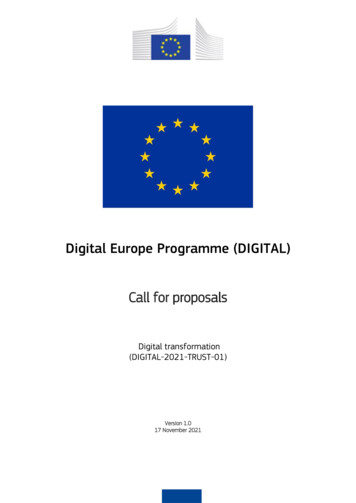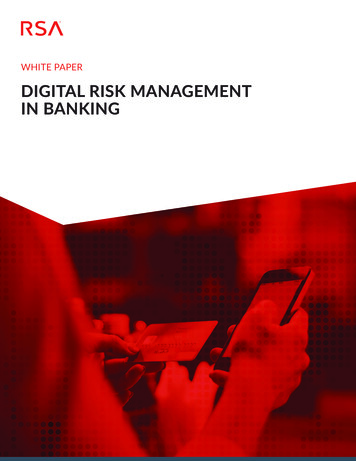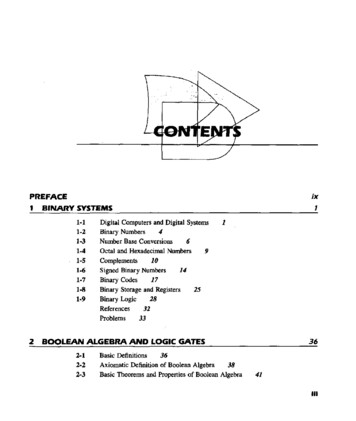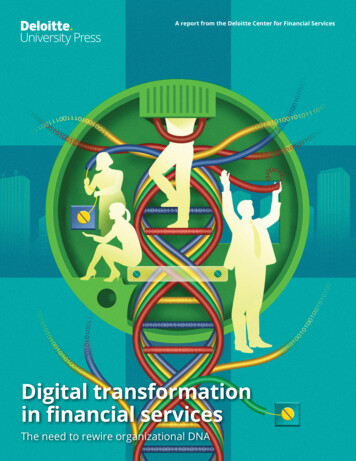
Transcription
DIGITAL PLATFORMSAND SERVICES:A developmentopportunity for ASEANCommissioned by:
1Digital platforms and servicesA development opportunity for ASEANDIGITAL PLATFORMS AND SERVICESLeveraging the growth opportunities in ASEANCountries in ASEAN are increasingly implementing digital economy strategies to reap thefull benefits of the internet economy, which is largely dependent on people being able touse digital platforms and services, such as e-commerce and cross-border data flows.EXPANSION OPPORTUNITY WITHACCESS TO 660m CONSUMERSOnline access is steadily increasing in the region with mobile-broadbandsubscriptions and internet usage now reaching more than half of thepopulation in most ASEAN ve mobilebroadband subscriptionsper 100 inhabitantsASEAN citizensusing the internet(% of population)International Telecommunication Union 2017. /default.aspxWorld Bank 2017. SREGULATORY BARRIERS ARERESTRICTING TRADEMore needs to be done to stimulate the ease of doing business inthe region. Data localisation regulations decrease economies ofscale for global companies, and potentially limit the opportunitiesfor local enterprises to take advantage of them.Ease of doing businessCross-border data nSources:World Bank 2017. http://www.doingbusiness.org/en/rankingsThe ASEAN Post 2018. -southeast-asiaBank Negara Malaysia http://www.bnm.gov.my/index.php?ch 57&pg 543&ac 692&bb file The Economist Intelligence Unit Limited 2019
Digital platforms and services2A development opportunity for ASEANGROWTH STRATEGIESCompanies across the region are employing a range of strategiesin order to capture the growth opportunity.US 1trnBETTER MARKET ACCESSThe boost to ASEANtrade and GDP thatcould be achieved by2025 by harnessingthe digital economy.6ASEAN companies benefit from easier access to regional and global consumers andbusiness support including financing, insurance and digital marketing via initiatives suchas Malaysia’s Digital Free-Trade Zone (DFTZ), which includes an electronic world tradeplatform. Order fulfilment is also aided by platforms such as Lazada, which providesbusinesses with e-commerce and logistics support.1SEAMLESS PAYMENTS660mpeopleBusiness transactions in the region have become more seamless thanks to mobilewallets such as GrabPay, which operates in six major ASEAN countries. The mobilewallet allows consumers to pay for transport and delivery services, peer-to-peertransactions, online purchases and QR code payments to offline merchants via anintegrated and secure platform.2The size of the ASEANopportunity for companieslooking to expand intothe third largest marketin the world, which has risingincome levels.7GROWING THE CUSTOMER BASEBusinesses can leverage established digital platforms to reach untappedASEAN markets and grow their customer base. Expedia, for example, supportsThailand’s “Go Local” campaign by promoting the country’s secondary touristdestinations on its online travel service platform.3BUILDING PARTNERSHIPSFintech firms have access to a digital marketplace and sandbox platform—API Exchange, launched by The ASEAN Financial Innovation network—thatallows them to connect with one another, collaborate with industry playersin a regulatory sandbox, and provide application programming interfacesthat support digital transformation and financial inclusion across the region.4BREAKING DOWN TRADE BARRIERSCompanies can expedite cross-border customs documentation and cargoclearance within ASEAN member states thanks to the ASEAN SingleWindow—an integrated digital platform that provides secure IT architectureand a legal framework that enables trade, transport and commercial data tobe exchanged rces/Media%20Release/Fact Sheet DFTZ at Malaysia Digital Economy 2018 SME Fact missioned by: The Economist Intelligence Unit Limited 2019
3Digital platforms and servicesA development opportunity for ASEANDigital platforms and services: A development opportunity forASEAN is a report from The Economist Intelligence Unit commissionedby the Asia Internet Coalition (AIC), which examines the mutualopportunities and challenges of digital platforms and service providers,and governments in the Association of Southeast Asian Nations(ASEAN) countries.Kim Andreasson was the author of the report; Scott Aloysius providedthe infographic that accompanies this paper; and Charles Ross wasthe editor. To better understand the opportunities and challengesin developing digital platforms and services in ASEAN markets, TheEconomist Intelligence Unit conducted wide-ranging desk researchsupplemented by six in-depth interviews with senior executives andexperts, between October 2018 and January 2019. Our thanks are dueto the following interviewees for their time and insights: Ang Choo Pin, senior director, Government and Corporate Affairs,Asia, Expedia Group Mich Goh, head of public policy, South-east Asia, Airbnb Steven Furst, director of strategy and architecture for the publicsector, FPT Information Systems Kok Yam Tan, deputy secretary, Smart Nation and DigitalGovernment, Singapore Daniel Castro, vice-president, Information Technology andInnovation Foundation Jane Treadwell, practice manager, Digital Development GlobalPractice, East Asia and Pacific, South Asia, Europe and Central Asia,and Latin America and Caribbean, World Bank GroupThe Economist Intelligence Unit bears sole responsibility for theeditorial content of this report; the findings do not necessarily reflectthe views of the sponsor. The Economist Intelligence Unit Limited 2019
Digital platforms and services4A development opportunity for ASEANContents5Executive summary7Introduction9CASE STUDY: Airbnb tailoring experiences for the ASEAN market12 Digital opportunities14 CASE STUDY: Digital payments in ASEAN—going cashless15 BOX: E-commerce in ASEAN—work needed to capture the opportunity17 Barriers to digital for good19 CASE STUDY: Benefits of digital platforms and services19 BOX: Data privacy issues22 The digital economy marches on23 CASE STUDY: Expedia Group bringing global experience to thelocal ASEAN market25 Conclusion27 BOX: Six key takeaways for governments and enterprises The Economist Intelligence Unit Limited 2019
5Digital platforms and servicesA development opportunity for ASEANExecutive summaryDigital platforms and services stimulateeconomic growth and development. Countriesare looking to the “internet economy” toprovide new market opportunities and helpachieve the UN’s Sustainable DevelopmentGoals (SDGs) such as promoting economicgrowth and sustainable industralisation, aprocess often relying on an increase in onlineaccess rates and smartphone penetration.At the same time, many countries in ASEANinadvertently hinder the potential for digitalplatforms and services through a lack of dataprivacy regulations and the introduction ofdata localisation policies that prevent thefree flow of data across borders, leavingmany businesses in limbo.This report looks at the opportunities andchallenges facing digital platform providersin ASEAN countries. Research shows thatleading countries, such as Singapore, providean accommodating regulatory environment,while other countries in the region offermajor opportunities in terms of scale butalso present challenges.1To provide insight into the role of digitalplatform providers in ASEAN, The EconomistIntelligence Unit conducted desk researchand six in-depth interviews. The key findingsof the research are as follows: ASEAN countries are deploying differentstrategies to capture the potential ofthe internet: data show that the internetis now used by more than half the world’spopulation. In response, governments1 http://www.doingbusiness.org/en/rankings The Economist Intelligence Unit Limited 2019around the world have adopted variousdigital economy strategies. In ASEAN, thoseefforts include Thailand 4.0, Myanmar’sDigital Economy and Singapore’s SmartNation programmes, among others. Connectivity matters: to capture thebenefits of an internet economy, increasingconnectivity and improving digital skills arekey to further development. These areasare also supported by the private sector inmany ways, including through investmentsin infrastructure and support of localpartners, such as non-governmentalorganisations and governments, to bridgedigital divides. Regulatory hurdles can stifle innovationand growth: some countries in ASEANhave introduced data localisation policies,which can limit economies of scale forglobal providers and domestic companies.In some jurisdictions, data privacyregulations are either unclear or potentiallyadd additional burden to the cost ofdoing business. Overcoming challenges throughinnovation: public- and private-sectorengagement is the most frequently citedsolution to challenges and potentiallyseizing the full benefits of the interneteconomy. Such solutions extend to largemultinational companies working withregional and local partners through creativecollaborations, as illustrated by Airbnb andExpedia Group (see case studies).
Digital platforms and services6A development opportunity for ASEAN The Economist Intelligence Unit Limited 2019
7Digital platforms and servicesA development opportunity for ASEANIntroductionEnhancing digital access and usage allowscountries—and their populations—to save time,money and effort while enhancing productivity.Globally, the internet contributed 3.4% of GDP tothe world’s 13 largest economies in 2009 and 5.3%of GDP in the G20 in 2016.2 The benefits of thedigital economy are set to increase. In 2018 theInternational Telecommunication Union, a UNagency, found that more than half of the world’spopulation is now online.3 The potential benefitsof digital development are huge.maturity of government and key digital ‘assets’,and strategic initiatives that span and engage theecosystem of actors.”It is estimated that the ASEAN region can seeUS 1trn added to its GDP by 2025 if the digitaleconomy can thrive and avoid barriers.4Countries around the region are increasinglyimplementing digital economy strategies (seebox on digital payments in ASEAN) to reap thefull benefits of the internet economy, whichis largely dependent on people being ableto use digital platforms and services, such ase-commerce and cross-border data flows. Thenumbers are encouraging: mobile-broadbandsubscriptions have increased and now reachmore than half of the population in mostmarkets; similarly, online access is steadily rising,again reaching more than half of the populationin most countries in the region.“The growth of the digital economy is anticipatedto reach 25% of global GDP in less than a decade,”says Jane Treadwell, who is the practice managerof the Digital Development Global Practice at theWorld Bank, covering East Asia and Pacific, SouthAsia, Europe and Central Asia, and Latin Americaand the Caribbean. “To be an active participantin the digital economy policy, it is crucial to havean enabling regulatory environment, the digitalFigure 1: More than half of ASEAN is connectedActive mobile-broadband subscriptions per 100 etnam40Laos020406080Source: International Telecommunication Union 20172 loads/2017/01/Measuring-Internet-Economy.pdf3 -offline/4 push-asean-gdp-up-1t-if-markets-operate-as-one/ The Economist Intelligence Unit Limited 2019100120140160
Digital platforms and services8A development opportunity for ASEANFigure 2: ASEAN internet usage is pervasiveASEAN citizens using the internet (% of population; select Myanmar25%Laos22%020406080100Source: World Bank 2017With a potential customer base of morethan 650m people, ASEAN is viewed as anexpansion opportunity for global digitalplatform providers. Singapore, for example,has enjoyed much success in attracting foreigncompanies owing to its open regulatoryenvironment, which is illustrated by the citystate’s second-place ranking in the World BankGroup’s Doing Business Index 2019.5 “We striveto be open to change,” says Kok Yam Tan, whois the deputy secretary of Smart Nation andDigital Government, which is part of the PrimeMinister’s Office in Singapore.Other ASEAN countries lag in terms of theWorld Bank’s index, with Malaysia ranked 15thglobally, followed by Thailand (27th), Vietnam(69th), Indonesia (73rd), and the Philippines(124th), indicating that more needs to be doneto make doing business in the region easier.Regulations concerning access and usage ofdigital platforms limit their full benefits. But therapid development of the information society,spurred by the growth of the internet economy,has now accentuated their importance. Oldchallenges, such as legacy policy regulationsand differences in adoption due to a lack ofdigital skills, remain key hurdles to greaterparticipation in the digital economy, however.At the same time, new obstacles such asdata localisation and questions surroundingdata privacy are emerging almost as quicklyas the development of technology. “We areencouraging governments to look at creatinglong-term sustainable policies instead ofmaking short-sighted decisions,” says AngChoo Pin, senior director for Government andCorporate Affairs in Asia at the Expedia Group,a global online travel platform. The Economist Intelligence Unit Limited 2019
9Digital platforms and servicesA development opportunity for ASEANCASE STUDY: Airbnb tailoring experiences for the ASEAN market“The way we operate from a regulatory point of view is to treat every countrydifferently and tailor our regulation engagement to realities on the ground,” saysMich Goh, head of public policy for South-east Asia at Airbnb, about the challenges ofoperating across ASEAN as a digital platform provider. Headquartered in San Francisco,the company is a global online travel and accommodation marketplace that offerslodging and tourism experiences in more than 191 countries and has in excess of 6mlistings.5 “The starting point is to have a discussion with governments to collaboratein every country where we operate,” Ms Goh continues.OpportunitiesTourism is booming in many ASEAN countries. Vietnam, for example, witnessed a 30%year-on-year increase in 2017, welcoming almost 13m international visitors, and the sectorcontributed about 7% to the country’s GDP.6 As a result, governments in the regionare generally receptive to hear about trends in tourism and are open to technologyplatforms that can further enhance such patterns, especially for younger travellers.“South-east Asia is quite diverse but, as a whole, governments are trying to understandand leverage the role tourism plays in the economy,” explains Ms Goh, and alludes to aninteresting correlation where the larger tourism markets also seem to be the most openand supportive of digital platforms that may increase tourist numbers. Ms Goh notesthat “they understand that travel is changing and when it is a big part of the economy,they tend to be much more open to collaboration.”ChallengesA broader challenge for Airbnb and other platform providers concerns data localisationregulations that often have a particular impact on internet platform providers andservices because they limit cross-border data flows due to perceived national securityand data privacy reasons. “It is a growing trend in ASEAN to localise data,” says MsGoh. “It increases the cost of doing business and makes it particularly challenging formultinationals to operate efficiently across markets.”Home privacy, meanwhile, is a challenge for Airbnb specifically. As such, Airbnb takescautionary measures to ensure its community behaves responsibly. “We are proud to5 https://press.airbnb.com/fast-facts/6 development.html The Economist Intelligence Unit Limited 2019
Digital platforms and services10A development opportunity for ASEANhave built a safe and compassionate community that is growing, because it is built ontrust.” says Ms Goh. In addition to key safety features it has built into the platform suchas risk scoring and account security, Airbnb regularly communicates expectations ofhost and guest behaviour via established Community Standards, and shares tips onresponsible hosting and guesting. “Irresponsible guests and hosts have no place in ourcommunity, and we do not hesitate to remove them from our platform,” she adds.ConclusionCompanies often work with governments to educate and inform them about thebenefits they can bring to the economy and less advantaged communities. “At Airbnb,we aim to help governments see that there is a way for underserved communities toplay a larger role in the broader tourism economy, not only through partnerships withgovernments but also with local stakeholders,” says Ms Goh. Airbnb usually workswith local organisations to better understand the realities on the ground and adopta train-the-trainer approach, in which they conduct training workshops for localorganisations and community leaders to understand the potential of digital platformsand raise awareness of their benefits. To promote digital inclusion in Thailand, forexample, Airbnb has partnered with the Thailand Department of Local Administrationto facilitate digital empowerment for local Thais in traditionally under served areas, tobe able to use the Airbnb platform and welcome guests from around the world.“Education is an ongoing process,” says Ms Goh. “Over time, we are seeing anevolution in understanding and partnerships with government are especially crucial todemonstrate the impact on local communities.” As a result, governments are willing toengage with digital platforms and service providers towards jointly fostering greatereconomic empowerment among local communities.Global players such as Airbnb are increasingly offering new types of services as well. Nolonger simply an accommodations provider, the company now also offers “experiences”,which are handcrafted activities provided by local host experts. “The services weprovide ultimately empower individuals in their markets to run their own tourismbusiness,” says Ms Goh, who points out that being open to engagement is the mostimportant aspect of development for countries and companies alike. “Governments thatare most open to promoting digital transformation are the ones that understand how tocreate growth models that optimise what technology can achieve.” The Economist Intelligence Unit Limited 2019
11Digital platforms and servicesA development opportunity for ASEAN5 http://www.doingbusiness.org/ The Economist Intelligence Unit Limited 2019
Digital platforms and services12A development opportunity for ASEANDigital opportunities“It is important to look at underservedcommunities to understand a country’s digitaltransformation journey in ASEAN because thereis inequality in adoption,” says Mich Goh, headof public policy for South-east Asia at Airbnb,a global online travel and accommodationmarketplace. “Governments play a big role inensuring equal access to services.” This canoften pose a challenge for cash-strappedgovernments in ASEAN; however, they alsorealise that digital inclusion can help supportsocio-economic growth, and by extension,help them acheive some of the UN SDGs.From e-health and e-education to e-tourismand fintech, digital platform providersand services can help across sectors.Expedia Group, for example, has signeda Memorandum of Understanding withThailand to increase tourism in underservedareas (see case study). Similarly, Airbnb hassigned partnerships focused on hospitalityand digital skills training workshops targetingunderserved populations—these benefit thecompany, the recipients, and economies as awhole (see case study).Companies can promote good corporatesocial responsibility, encourage private-sectorinnovation (particularly in the developmentof smart cities) and leverage mobile platformsand technologies to support greater inclusion,which holds immense promise for bothcorporate and economic development.“One key trend is when computing goesbeyond the desktop or laptop,” saysMr Tan. “Sensors and IoT [the Internet ofThings] open up a world of new opportunitiessuch as smart cities, and industries need toadapt in terms of business innovation.”Regional innovationASEAN is an attractive destination for globalcompanies and investors, including digitalplatform providers that offer localisedversions of their services and help connectmore people and small and medium-sizedbusinesses in Asia to global audiences. At thesame time, the region is increasingly producingits own set of innovative internet companiesthat aspire to enter new markets.There are initiatives across the region’seconomies that support this trend, includingthe development of special economic zonesthat seek to draw investment and encourageinformation exchanges, and governmentefforts to promote digitalisation and theinternet economy.MSC Malaysia, for example, is a specialeconomic zone near Kuala Lumpur thattargets both international investment andthe development of local businesses.7 As ofFebruary 2018 it has attracted participationfrom more than 3,000 companies.In Vietnam, FPT is an example of a localcompany going global rapidly, includinginto Europe, North America, Japan, andnearby ASEAN countries. Starting as a foodprocessing technology company, hence theacronym FPT, the enterprise now operates in45 countries and has over 23,000 employees.8“FPT is as capable as any other technologyservices provider and operates around theworld,” says Steven Furst, director of strategyand architecture for the public sector at FPTInformation Systems. “Vietnam has a largepool of excellent engineers,” he cites as a keyingredient for the company’s success.7 https://www.mdec.my/msc-malaysia8 https://fpt.com.vn/en/about-us The Economist Intelligence Unit Limited 2019
13Digital platforms and servicesA development opportunity for ASEANIn Singapore, the government takes severalinitiatives to promote the digital economy.Besides smart city development plans,the country has embarked on a range ofassociated projects, such as improvinge-government service delivery to citizens,open government data-sharing with theprivate sector and standardised e-payments(see box on digital payments in ASEAN).The city state is often a test-bed for newinnovations that can benefit digital platformproviders. In 2016, for example, the Singaporegovernment partnered with self-driving carstart-up nuTonomy, to develop the world’s firstdriverless taxi system.9The ASEAN region holds great promise, fromadvanced technologies to large markets.At the same time governments across theregion are increasingly interested in digitaleconomy strategies that can benefit bothsocio-economic development and local andglobal private-sector companies to provide awin-win situation.9 m-comes-to-singapore.html The Economist Intelligence Unit Limited 2019
Digital platforms and services14A development opportunity for ASEANCASE STUDY: Digital payments in ASEAN—going cashless“I heard Singapore is getting rid of coins to promote a cashless society,” an official inMyanmar once said. “We’re one step ahead because we never had coins.” The racetowards digital payments of all forms is supported by governments and companies alikefor the same reason: efficiency. Digital payments enable cheaper and faster transactionswith greater transparency.Business transactions in individual countries have become more seamless thanksto mobile wallets (e-wallets), such as GrabPay, which operates in six major ASEANcountries: Singapore, Malaysia, Indonesia, Vietnam, the Philippines and Thailand. Themobile wallet allows consumers to pay for transport and delivery services, peer-to-peertransactions, online purchases and provides QR code payments to offline merchants viaan integrated and secure platform.10In ASEAN more broadly, however, there is a lack of standardised e-payments (ore-wallets). That there are no strong incumbent solutions can be an advantage for someparts of ASEAN, as innovations flourish. However, in many countries, such as Myanmar,there are multiple solutions and, as providers have systems that are not interoperable,it can lead to inefficiencies and confusion. This is one reason that Singapore hasestablished a single system from which various actors can benefit and compete on anequal level.11“Our central bank is actively promoting e-payments,” says Kok Yam Tan, who is thedeputy secretary for Smart Nation and Digital Government in Singapore. “A key aspectof our approach is to provide the underlying platforms for interoperability so as to allowthe market to provide solutions.” As a result, Singapore has established both PayNowand SGQR, which uses QR codes for payments—these are interoperable systems thatprovide an equal market opportunity for businesses.As a sign of changing times, development used to be tracked, in part, by the number ofATM machines and bank branches per head, but not any longer as advanced countriesnow see fewer of them. In Sweden, remaining branch offices are often “cashless”,meaning they don’t hold any money at all, a trend that is spreading to restaurants andhotels, and one that in the long-run will benefit digital platforms that frequently operateunder the same conditions. In Vietnam, for example, digital platforms that used todeliver food for cash on delivery now accept digital payments in addition to money.10 -by-kbank/11 ustoms-clearance The Economist Intelligence Unit Limited 2019
15Digital platforms and servicesA development opportunity for ASEANBOX: E-commerce in ASEAN—work needed to capture the opportunityThe rise of e-commerce has been rapid and can be illustrated by the amount of electronictransactions. In 1999 the value of e-commerce among the world’s 300m internet userswas estimated at US 110bn.12 In 2013 global business-to-business (B2B) e-commercereached about US 15trn with business-to-consumer (B2C) e-commerce accountingfor another US 1.2trn, according to the UN Conference on Trade and Development(UNCTAD).13The growth of e-commerce can also be illustrated by digital platform providers thatserve as the link between sellers and buyers. When Alibaba, the Chinese e-commercegiant, listed on the New York Stock Exchange in 2014, it was initially valued at aroundUS 230bn, making it one of the 20 biggest companies by market capitalisation in the US.14As of 2018, Alibaba had customers in more than 190 countries in the world and featuredsellers across ASEAN.15The adoption of e-commerce in ASEAN has been relatively slow, however. In theUNCTAD B2C E-Commerce Index 2017, Singapore ranked first in ASEAN, but only 18thglobally, followed by Malaysia (38th), Thailand (49th), Vietnam (74th) and the Philippines(96th), indicating that the region needs to make progress. For example, Malaysia’sNational eCommerce Strategic Roadmap aims to double annual e-commerce growthfrom 10.8% in 2016 to 20.8% in 2020.16 A lack of digital payments options and physicalinfrastructure are commonly cited challenges in the region, which limit the full benefitsof e-commerce.12 https://www.wto.org/english/res e/publications e/ecom devel countries e.htm13 x?publicationid 114614 e-higher-in-ipo-141114212015 bout-alibaba.php16 https://www.miti.gov.my/index.php/pages/view/3834 The Economist Intelligence Unit Limited 2019
Digital platforms and services16A development opportunity for ASEAN The Economist Intelligence Unit Limited 2019
17Digital platforms and servicesA development opportunity for ASEANBarriers to digital for goodThe challenges for established enterprises andstart-ups in ASEAN in terms of current policyand regulatory approaches being taken bydifferent governments vary. They range fromdata localisation regulations and data privacyinitiatives—or the lack thereof—to improvingdigital skills and enhancing cyber-security.“Silo developments that exclude others fromparticipation will likely destroy value in thelong term,” says Mr Tan.Data localisation and content restrictionsare increasingly common across the region,hampering digital platform and serviceproviders, in particular international ones.Such policies are frequently crafted fornational security purposes,
Economist Intelligence Unit conducted wide-ranging desk research supplemented by six in-depth interviews with senior execu











